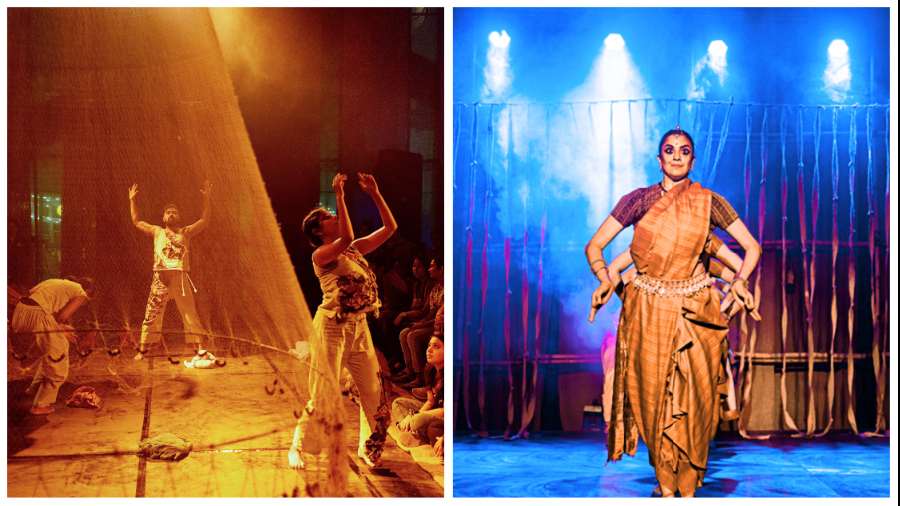An engaging mix of dance and movement works — rich, varied, experimental and often provocative — was expected of Pickle Factory’s fourmonth-long third season. What astonished even the seasoned critic, however, were the spaces that the works inhabited and grew out of. Unusual sites in Calcutta opened up generously for dance, their moods and moments manifest in the DNA of the choreographies. The result was a daring festival of movement arts that took the city by storm and persuaded one to look at dance a little differently.
The season opened with Shashwati Garai Ghosh’s rousing Mahamaya (picture, right), which converted the Behala Natun Dal Durga Puja pandal into an exquisite dance venue. The choreography, as intricate as lace, created a marvellous narrative that was both exhilarating and meditative. In celebrating the eponymous goddess, the piece magically illuminated the space, giving it a rare and compelling beauty. The same location, on another evening, heaved with raw energy when the decidedly grungy and anti-spectacular Detritus (picture, left), conceived by Paramita Saha, was staged there. With the environmental crisis at its heart, the work situated itself powerfully at the intersection of art and activism, completely unpretentious in its dedication to the cause of ecological balance and sustainability.
Inspired by ritualistic practices, Surjit Nongmeikapam’s Meepao, which is firmly rooted in the Northeast, underscored the minimalism of the same Natun Dal venue. The choreography harnessed terrific energy as the dancers grouped, broke out, and regrouped purposefully across the space in grippingly repetitive, rhythmic patterns. Although not political in the way that Surjit’s other works are, Meepao was powerful and overwhelmingly dense.
The open space in the NSHM Knowledge Campus was a compelling setting for the achingly beautiful duet, 111, of the ballet dancer, Eve Mutso, and the paraplegic dancer, Joel Brown. Not only did it challenge one’s understanding of dance and its demands on the body but it also made one enquire into the very nature of collaboration, taking the quest deeper into the intimate areas of relationship and trust. The two incredible dancers explored their strengths but did not shy away from exposing their vulnerabilities in a thrilling display of inspired physicality.
Kattaikuttu Sangam’s Tavam, presented as a part of the Kolkata Centre for Creativity’s Ami Arts Festival along with Pickle Factory, was a modern take on the age-old Koothu theatre of Tamil Nadu. The play within a play structure allowed it to explore, contextualise and comment on what happens when a group of rebellious women breaks into the Koothu performance space, which is traditionally a male bastion.
What Talk of Body, choreographed by Anoushka Kurien and performed at the café, Offbeat CCU, shunned visual allure for more fundamental questions rooted in the present. A post-modern experimental work with a text, it explored the ideas of relationship, dislocation and alienation.
Working on city dancers to create a Calcutta version of her invigorating and thought-provoking Terms and Conditions Apply, Aseng Borang proposed a game that was as much fun as it was dangerous. The space at The Creative Arts Academy was laid out with chairs and the audience was invited to sit with the performers. The game ensued. As it progressed, there was a palpable excitement in the room and the piece shifted very cleverly to reveal the emotional dynamics of the players even as the chair acquired sinister connotations of power and control.











